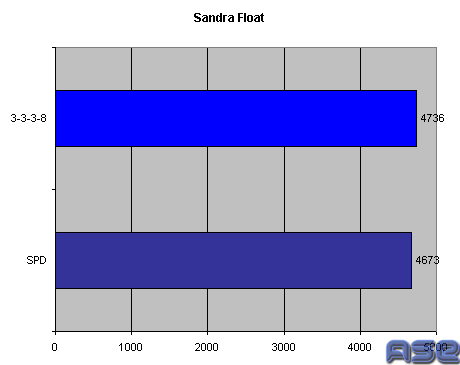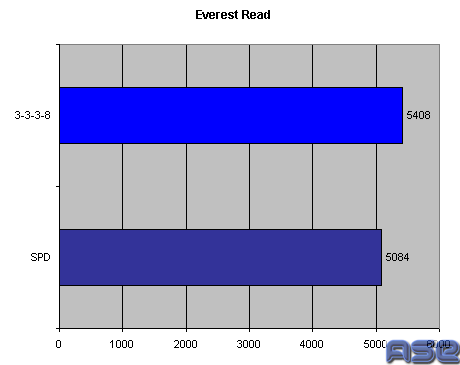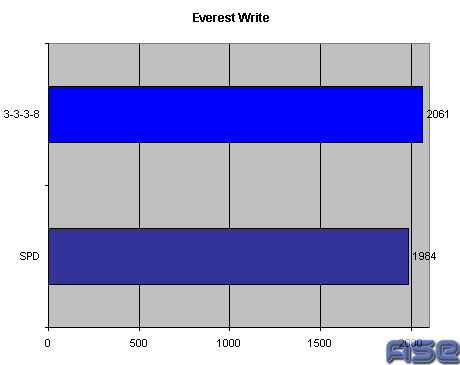Page All: Viewing All Pages
Page 1
Since I can remember, <a href="http://www.mushkin.com">Mushkin</a> has been providing the enthusiast community with superior RAM modules that are known to overclock extremely well. We are in a new generation of RAM modules, DDR2. This new type is still uncertain and in its infancy in the market. Currently, only the newest Intel chips can use this type of memory, but that will surely change soon. Let's take a look at the new Mushkin PC2-4200 1024MB kit.
<B>DDR2?</B>:
What's the difference between DDR and DDR2 you may be asking. Well, let's go over the differences.
The first and perhaps most obvious is the socket difference. The normal DDR DIMM has 184 contacts. The new DDR2 module has a total of 240 contact and the notch is different, so you shouldn't have a problem determining which type of memory you have (or if you have the wrong memory for your motherboard). The second is the packaging used for the chips. While most of the DDR modules used the older TSOP method of chip packaging, the newer DDR2 uses FBGA. The other improvements to DDR2 include On-Die Termination and Off-Chip Driver calibration. While JEDEC says that DDR can go up to 1GB per module, DDR2 can go up to 4GB. And, normally, DDR memory runs at 2.5V while the newer DDR2 runs at 1.8V Laptop users rejoice!
Now that you know what we're dealing with, let's move on to the product of the review.
<B>The Mushkin Way</B>:
<center> </center>
</center>
Mushkin has a pretty funny way of packing their modules. Even though I got a kick out of it, the only way something bad could happen to the modules is if the protective balloon burst. Pretty intelligent packaging.
<B>The Modules</B>:
<center> </center>
</center>
Opening up the balloon and releasing the modules, you can see the ESD bag they are further protected it and shrink wrapped. More protection is good.
<center> </center>
</center>
You can see the pins on the DDR2 module right here. They are smaller and more densely packed than DDR modules. The notch is also in a different place. Don't try to push these into the DDR1 slots, they'll break your motherboard and the module.
Since I can remember, <a href="http://www.mushkin.com">Mushkin</a> has been providing the enthusiast community with superior RAM modules that are known to overclock extremely well. We are in a new generation of RAM modules, DDR2. This new type is still uncertain and in its infancy in the market. Currently, only the newest Intel chips can use this type of memory, but that will surely change soon. Let's take a look at the new Mushkin PC2-4200 1024MB kit.
<B>DDR2?</B>:
What's the difference between DDR and DDR2 you may be asking. Well, let's go over the differences.
The first and perhaps most obvious is the socket difference. The normal DDR DIMM has 184 contacts. The new DDR2 module has a total of 240 contact and the notch is different, so you shouldn't have a problem determining which type of memory you have (or if you have the wrong memory for your motherboard). The second is the packaging used for the chips. While most of the DDR modules used the older TSOP method of chip packaging, the newer DDR2 uses FBGA. The other improvements to DDR2 include On-Die Termination and Off-Chip Driver calibration. While JEDEC says that DDR can go up to 1GB per module, DDR2 can go up to 4GB. And, normally, DDR memory runs at 2.5V while the newer DDR2 runs at 1.8V Laptop users rejoice!
Now that you know what we're dealing with, let's move on to the product of the review.
<B>The Mushkin Way</B>:
<center>
 </center>
</center>Mushkin has a pretty funny way of packing their modules. Even though I got a kick out of it, the only way something bad could happen to the modules is if the protective balloon burst. Pretty intelligent packaging.
<B>The Modules</B>:
<center>
 </center>
</center>Opening up the balloon and releasing the modules, you can see the ESD bag they are further protected it and shrink wrapped. More protection is good.
<center>
 </center>
</center>You can see the pins on the DDR2 module right here. They are smaller and more densely packed than DDR modules. The notch is also in a different place. Don't try to push these into the DDR1 slots, they'll break your motherboard and the module.
Page 2
<B>Testing</B>:
Let me go over some caveats of the testing done on this memory. Since this is the first sample of DDR2 I have, and my resources are limited at this time (I am a college student after all), I will not be going over any overclocking results. I simply do not have the resources at this time to do so. Rest assure, in the near future, I'll be receiving more memory and better DDR2 test beds and when I do, I'll revisit the RAM reviewed here. My apologies to the readers and to Mushkin.
The test setup used was a Pentium 4 550 (3.4GHz). Windows 2000 with SP4 and all the hotfixes. Yes, I still use Win2k. The RAM used was... you know. Radeon X700 Pro 256MB. 300GB Serial ATA Maxtor Hard Drive with 16MB cache! Intel 915PBL. New technology sucks, it is very expensive.
I did decide to mess with the timings a bit to determine how hard I could push the memory at stock MHz and at stock voltage. Needless to say, the memory ran flawlessly at the rated speeds. JEDEC says that 533MHz DDR2 should run at 4-4-4. The SPD said the RAM was rated at 5-4-4-12, which was strange to me. Although it said this, on auto, it was at 4-4-4-12. The board may just be screwing up stuff. Unsure. I pushed the RAM to 3-3-3-8 and it was running nice and stable. Anything lower and it would crash or not POST. The lighter blue on the graph is the faster latencies.
<center> </center>
</center>
Sandra Integer buffered shows the increased speed. The difference between DDR and DDR2 are yet to be seem in terms of raw speed.
<center> </center>
</center>
Same for float.
<center> </center>
</center>
Everest Read. Everest is the program that takes over from AIDA32.
<center> </center>
</center>
Same for the writes.
<center> </center>
</center>
Now for latency. You can see the benefit to decreasing the timings for the memory. I believe that DDR2 will get tighter and tighter timings in the coming months, just as normal DDR did.
<B>Conclusion</B>:
Without anything to compare this memory too, I will not give a recommendation based on it alone. I will say that the memory performed perfectly well at the stock timings and at a bit faster than it was rating for. <a href="http://ase.dealtime.com/dt-app/SE/KW-mushkin 533mhz/FD-0/linkin_id-3002062/NS-1/GS.html">The price for this memory is about $350</a>!! This is pretty high for memory, but you are getting quality. I leave it to you to decide whether to purchase this memory or not. It is your money after all.
I'd like to thank <a href="http://www.mushkin.com">Mushkin</a> for providing the first DDR2 modules for review here.
<B>Testing</B>:
Let me go over some caveats of the testing done on this memory. Since this is the first sample of DDR2 I have, and my resources are limited at this time (I am a college student after all), I will not be going over any overclocking results. I simply do not have the resources at this time to do so. Rest assure, in the near future, I'll be receiving more memory and better DDR2 test beds and when I do, I'll revisit the RAM reviewed here. My apologies to the readers and to Mushkin.
The test setup used was a Pentium 4 550 (3.4GHz). Windows 2000 with SP4 and all the hotfixes. Yes, I still use Win2k. The RAM used was... you know. Radeon X700 Pro 256MB. 300GB Serial ATA Maxtor Hard Drive with 16MB cache! Intel 915PBL. New technology sucks, it is very expensive.
I did decide to mess with the timings a bit to determine how hard I could push the memory at stock MHz and at stock voltage. Needless to say, the memory ran flawlessly at the rated speeds. JEDEC says that 533MHz DDR2 should run at 4-4-4. The SPD said the RAM was rated at 5-4-4-12, which was strange to me. Although it said this, on auto, it was at 4-4-4-12. The board may just be screwing up stuff. Unsure. I pushed the RAM to 3-3-3-8 and it was running nice and stable. Anything lower and it would crash or not POST. The lighter blue on the graph is the faster latencies.
<center>
 </center>
</center>Sandra Integer buffered shows the increased speed. The difference between DDR and DDR2 are yet to be seem in terms of raw speed.
<center>
 </center>
</center>Same for float.
<center>
 </center>
</center>Everest Read. Everest is the program that takes over from AIDA32.
<center>
 </center>
</center>Same for the writes.
<center>
 </center>
</center>Now for latency. You can see the benefit to decreasing the timings for the memory. I believe that DDR2 will get tighter and tighter timings in the coming months, just as normal DDR did.
<B>Conclusion</B>:
Without anything to compare this memory too, I will not give a recommendation based on it alone. I will say that the memory performed perfectly well at the stock timings and at a bit faster than it was rating for. <a href="http://ase.dealtime.com/dt-app/SE/KW-mushkin 533mhz/FD-0/linkin_id-3002062/NS-1/GS.html">The price for this memory is about $350</a>!! This is pretty high for memory, but you are getting quality. I leave it to you to decide whether to purchase this memory or not. It is your money after all.
I'd like to thank <a href="http://www.mushkin.com">Mushkin</a> for providing the first DDR2 modules for review here.
